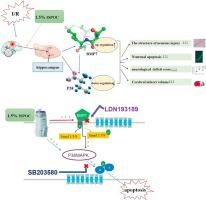当前位置:
X-MOL 学术
›
J. Chem. Neuroanat.
›
论文详情
Our official English website, www.x-mol.net, welcomes your
feedback! (Note: you will need to create a separate account there.)
Isoflurane post-conditioning attenuates Cerebral Ischemia/Reperfusion Injury by reducing apoptotic through Activating the BMP7/SMAD Signaling Pathway in Rats
Journal of Chemical Neuroanatomy ( IF 2.7 ) Pub Date : 2021-03-01 , DOI: 10.1016/j.jchemneu.2020.101916 Mingyue Ge 1 , Jiangwen Yin 1 , Xinlei Qin 1 , Jingwen Zhai 1 , Xiuzhi Shao 1 , Ruixue Wang 1 , Shiwen Fan 1 , Zhigang Dai 1 , Sheng Wang 2 , Yan Li 1
Journal of Chemical Neuroanatomy ( IF 2.7 ) Pub Date : 2021-03-01 , DOI: 10.1016/j.jchemneu.2020.101916 Mingyue Ge 1 , Jiangwen Yin 1 , Xinlei Qin 1 , Jingwen Zhai 1 , Xiuzhi Shao 1 , Ruixue Wang 1 , Shiwen Fan 1 , Zhigang Dai 1 , Sheng Wang 2 , Yan Li 1
Affiliation

|
The expressions of different temporal patterns of bone morphogenetic proteins (BMPs) have changed after ischemic strokes, and ischemic preconditioning-induced neuroprotection was attenuated when BMP7 was inhibited. In the previous study, the neuroprotection of isoflurane postconditioning (ISPOC) against cerebral ischemia-reperfusion (I/R) injury has been addressed, with particular relevance to the role of BMP7. Consequently, in the present study, we continued to explore the mechanisms involved in the BMP7 signal mediated the neuroprotection of ISPOC. A rat model of the middle cerebral artery occlusion was used in this study. Rats were administered 1.5% isoflurane, 60 minutes after 90 minutes of ischemia, followed by a 24 hour reperfusion period. The 1.5% ISPOC significantly ameliorated the cerebral infarct volumes, neurologic deficit scores, damaged neurons, and apoptotic neurons. Moreover, ISPOC unregulated the expressions of BMP7, p-Smad1/5/9, and p-p38. Whereas, the neuroprotective effect was weakened by LDN-193189 and SB203580, respectively, a BMP7/Smad1/5/9 and p38MAPK signaling pathway inhibitor. Furthermore, LDN-193189 downregulated the expression of p-p38. The present results of this study indicated that the neuroprotection of 1.5% isoflurane postconditioning to cerebral ischemia-reperfusion injury is related to the activating of BMP7/Smad1/5/9 and p38MAPK signal pathway.
中文翻译:

异氟醚后处理通过激活大鼠 BMP7/SMAD 信号通路减少细胞凋亡来减轻脑缺血/再灌注损伤
缺血性卒中后骨形态发生蛋白 (BMPs) 的不同时间模式的表达发生了变化,当 BMP7 被抑制时,缺血预处理诱导的神经保护作用减弱。在之前的研究中,异氟醚后处理 (ISPOC) 对脑缺血再灌注 (I/R) 损伤的神经保护作用已得到解决,尤其与 BMP7 的作用有关。因此,在本研究中,我们继续探索 BMP7 信号介导 ISPOC 神经保护的机制。本研究采用大鼠大脑中动脉闭塞模型。在缺血 90 分钟后 60 分钟给大鼠施用 1.5% 异氟醚,然后再灌注 24 小时。1.5% ISPOC 显着改善脑梗塞体积、神经功能缺损评分、受损的神经元和凋亡的神经元。此外,ISPOC 未调节 BMP7、p-Smad1/5/9 和 p-p38 的表达。而 LDN-193189 和 SB203580(BMP7/Smad1/5/9 和 p38MAPK 信号通路抑制剂)分别削弱了神经保护作用。此外,LDN-193189 下调 p-p38 的表达。本研究目前的结果表明,1.5%异氟醚后处理对脑缺血再灌注损伤的神经保护作用与BMP7/Smad1/5/9和p38MAPK信号通路的激活有关。LDN-193189 下调 p-p38 的表达。本研究目前的结果表明,1.5%异氟醚后处理对脑缺血再灌注损伤的神经保护作用与BMP7/Smad1/5/9和p38MAPK信号通路的激活有关。LDN-193189 下调 p-p38 的表达。本研究目前的结果表明,1.5%异氟醚后处理对脑缺血再灌注损伤的神经保护作用与BMP7/Smad1/5/9和p38MAPK信号通路的激活有关。
更新日期:2021-03-01
中文翻译:

异氟醚后处理通过激活大鼠 BMP7/SMAD 信号通路减少细胞凋亡来减轻脑缺血/再灌注损伤
缺血性卒中后骨形态发生蛋白 (BMPs) 的不同时间模式的表达发生了变化,当 BMP7 被抑制时,缺血预处理诱导的神经保护作用减弱。在之前的研究中,异氟醚后处理 (ISPOC) 对脑缺血再灌注 (I/R) 损伤的神经保护作用已得到解决,尤其与 BMP7 的作用有关。因此,在本研究中,我们继续探索 BMP7 信号介导 ISPOC 神经保护的机制。本研究采用大鼠大脑中动脉闭塞模型。在缺血 90 分钟后 60 分钟给大鼠施用 1.5% 异氟醚,然后再灌注 24 小时。1.5% ISPOC 显着改善脑梗塞体积、神经功能缺损评分、受损的神经元和凋亡的神经元。此外,ISPOC 未调节 BMP7、p-Smad1/5/9 和 p-p38 的表达。而 LDN-193189 和 SB203580(BMP7/Smad1/5/9 和 p38MAPK 信号通路抑制剂)分别削弱了神经保护作用。此外,LDN-193189 下调 p-p38 的表达。本研究目前的结果表明,1.5%异氟醚后处理对脑缺血再灌注损伤的神经保护作用与BMP7/Smad1/5/9和p38MAPK信号通路的激活有关。LDN-193189 下调 p-p38 的表达。本研究目前的结果表明,1.5%异氟醚后处理对脑缺血再灌注损伤的神经保护作用与BMP7/Smad1/5/9和p38MAPK信号通路的激活有关。LDN-193189 下调 p-p38 的表达。本研究目前的结果表明,1.5%异氟醚后处理对脑缺血再灌注损伤的神经保护作用与BMP7/Smad1/5/9和p38MAPK信号通路的激活有关。











































 京公网安备 11010802027423号
京公网安备 11010802027423号